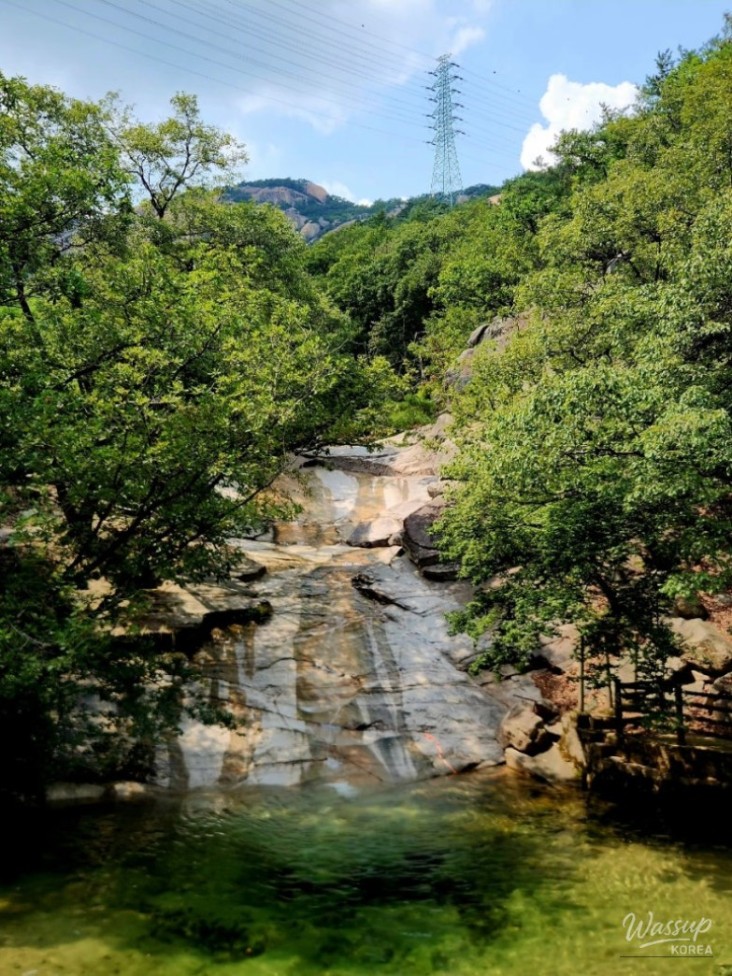Cycling to Suraksan Mountain's Waterfalls and Naewonam Temple

Yesterday I went to Namseoul (Cheonggyesan Mountain), and today it's North Seoul. Seoul is a city nestled comfortably in the center, surrounded by mountains on all sides. This makes outings in every direction – east, west, south, and north – easily accessible.
North Seoul is divided into east and west by the Jungnangcheon Stream. To the east, Suraksan Mountain proudly displays its majestic peaks, while Dobongsan Mountain dominates the west. So today, I went on a bike ride with Suraksan Mountain as my destination.
Suraksan Mountain is entirely composed of various granite peaks and oddly shaped rocks. Consequently, the water in the valleys is torrential when it rains, but dwindles to a trickle after a few days. Cycling on Suraksan Mountain is possible thanks to Seoklimsa Temple on the west side, and an uphill climb to Naewonam Temple on the east side. However, you can only cycle up to a certain point on the way to Naewonam Temple; from there, it's a staircase, so you have to park your bike and continue on foot.
My starting point was Yongbigyo Bridge, where the Jungnangcheon Stream meets the Han River. As I cycled east, I passed a view of the Lotte Tower.

Yongbigyo Bridge

Lotte Tower
Passing through Guri City and meeting Wangsukcheon Stream, I headed north. After passing Toegyewon, I met Deoksongcheon Stream in Byeollae and followed the stream northward. I rode along the new bike path of Deoksongcheon Stream, then followed Yongamcheon Stream, and finally entered the Suraksan Mountain direction using the public road to Uijeongbu.

Byeollae Deoksongcheon Bike Path

Road to Suraksan Cheonghakdong Valley
That's Suraksan Cheonghakdong Valley. From the bottom, you'll find Okgnyu Waterfall, Eunryu Waterfall, and finally Geumnyu Waterfall at the uppermost reaches. My final destination was Naewonam Temple, where Geumnyu Waterfall is located.

Namyangju-si, Byeollae-myeon, Cheonghak-ri
I initially titled this post 'Naewonam Temple Riding', but since most people don't know Naewonam Temple, I changed it to the more eye-catching 'Suraksan Waterfall Riding'.

Naewonam Temple 1.5Km
Leaving the car park, I passed the vehicle restriction barrier and started up the paved road. The valley on the right is well-developed, so you can rest anywhere there's shade.

Okgnyu Waterfall has a lot of water because it's been dammed, but it's off-limits, so it's as good as dead in the blazing sun.

Okgnyu Waterfall
After that, the slope became steep, and I encountered roads that were damaged in places by heavy rain. Although vehicle access is prohibited, there were vehicles parked everywhere. It seems the principle of 'no rule without exception' applies here too.

Steep Road
People were sitting in small groups at good spots in the valley, chatting and dipping their feet in the water. But no one was taking a refreshing plunge. Indeed, Korea is a country of etiquette.

Bike parking here
I went up the stone path and found a staircase, so I locked my bike and left it there. I climbed the stone and rock stairs and found a wooden deck staircase. The sound of water was loud in the valley on the left. It was the sound of Eunryu Waterfall.

Stairway to Naewonam Temple
The forest grew deeper and deeper, and the path through the forest was like a beautiful painting. There's a Fairy Pond (Seonnyeotang) just below, so I decided to meet a fairy when I came back down.

Geumnyu Waterfall
The last part of the Naewonam Temple course is a steep stone staircase with a 45-degree incline. I almost lost my balance and fell down the cliff below. I barely made it up and found a detour.

Geumnyu Waterfall Path
Construction of Naewonam Temple began in 1794 during the reign of King Jeongjo. It was completely destroyed during the Korean War and rebuilt in 1955. The information board said that King Jeongjo had no heir, but Yongpa, the monk of this temple at the time, prayed for him and he saw a crown prince (Sunjo).

Naewonam Temple
Right below Naewonam Temple is the Naewonam snack bar, a famous place for cold kimchi noodle soup (yeolmu guksu) that only those in the know frequent. Its location is right above Geumnyu Waterfall, a prime spot with an amazing view. Therefore, it's a must-stop for Suraksan Mountain hikers. Dipping your feet in the cold spring water flowing next to the rocks while eating the noodles is heavenly. There are also many maple trees nearby, so it would be even better to visit in the fall.

Naewonam Snack Bar above Geumnyu Waterfall
I skinny-dipped in the Fairy Pond below Geumnyu Waterfall, took a water massage at the small waterfall to beat the heat, and then came down. Water massage is a seasonal custom on Yudu Day (June 15th in the lunar calendar), where people wash their hair and bathe in a stream flowing east or get massaged by the water under a waterfall. It is said to bring longevity, so it's a must when you go to the mountains. So stop being so polite and get a water massage!

Naewonam Valley Path
Water Massage
After descending from Cheonghakdong Valley, I headed to Deokneung Pass. Crossing the pass takes you to Sanggye-dong, Nowon-gu, Seoul, and many people hike Suraksan Mountain from the pass.

Deokneung Pass

Danghyeoncheon Stream
There's a well-maintained bike path along Danghyeoncheon Stream in Sanggye-dong. I met the Jungnangcheon Stream and sprinted to Yongbigyo Bridge, finishing today's ride. (I had to ride another 30km from the Yongbigyo rest area to get home.)

63.3Km

gpx



No comments yet.






